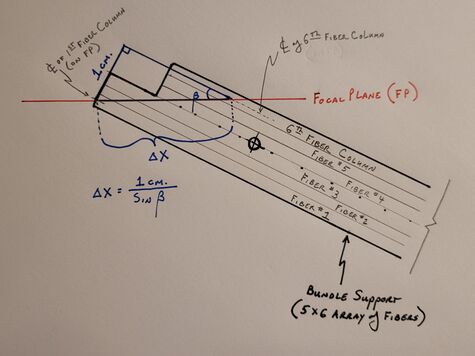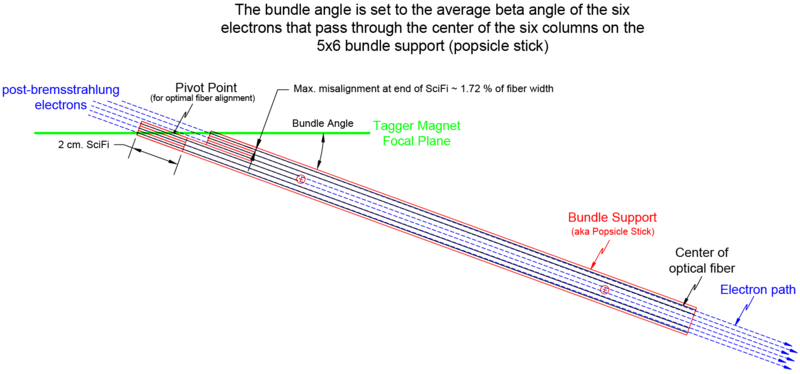Tagger Microscope Placement in the Tagger Hall
UNDER CONSTRUCTION
Tagger Microscope Placement in the Tagger Hall
When discussing the location of the Tagger Microscope (TAGM) within the Tagger Hall it is often easiest to reference the starting point of the energy spectrum being tagged. For example, if the TAGM is said to be placed at 9.2 GeV this would indicate that the location of the most upstream column of fibers, with respect to the beamline, is such that a post-bremsstrahlung electron associated with a 9.2 GeV emitted photon will pass through the longitudinal axis of this column of scintillating fibers (SciFi). This column is referenced as column #1 in Figure 1 below. As the column numbers increase the electrons' energy increases, and as such the energy of the associated photon being tagged decreases.
Every bundle support (a.k.a. popsicle stick) supports a 5x6 array of 30 fibers. Each individual fiber is constructed from a 2.0 cm long section of BCF-20 SciFi thermally fused to 163.1 cm of BCF-98 lightguide. These fibers have a 2 x 2 mm2 square transverse profile. The angle of each bundle support with respect to the focal plane (β angle) is selected to correspond to the average crossing angle as they pass through the focal plane of the electrons passing through these six columns of fibers. Therefore, for each bundle support there is a projection along this β angle that the support can be located and still remain within the design specifications of the TAGM. Since the β angle of the electrons only varies slightly over the entire bundle support's width, there is a fair amount of play with regard to how close the SciFi columns need to be to the focal plane of the Tagger Magnet, provided they remain along the electron of interest's path. To put this in prospective consider a bundle placed at around 9.2 GeV (Eγ). This 5x6 array of fibers will cover an energy range of 54 MeV and will see a change in β angle of only 0.11o from its first column of fiber to its last (6th column).
How to configure the scintillating fibers on the bundle support
The ideal configuration of the each fiber column would allow the center of the front face of the fibers to sit on the focal plane, as shown in Figure 2. Unfortunately, this configuration does not permit sufficient space to provide a method for holding the fibers in place other than gluing. During the prototyping phase testing showed that gluing the fibers to the bundle support was not a viable option due to unacceptable light loss, not to mention the difficult that would arise when trying to replace fibers. A 5x5 fiber configuration per bundle was used for the prototype, which was optically linked to a single preamplifier board. Unfortunately, having 25 silicon photomultipliers (SiPM) per preamplifier board led to too much electronic cross-talk and the likelihood of optical cross-talk between channels due to limited spacing between SiPM. Bundle supports with smaller fiber array configurations have too narrow of a base and could lead to improper alignment of the fibers due to the instability of the bundle support on the mounting rails. While using a bundle support with 6 or more columns side-by-side, as in Figure 3, extends the fibers too far past the focal plane in the y-direction. A compromise was reached by designing a bundle support with 30 fibers (5x6 array), which was split into two 5x3 fiber arrays (forward and rear bundle halves) offset to one another. This configuration shown in Figure 4 limits the fibers' intrusion past the focal plane (± YFP) and reduces the number of SiPM to 15 per preamplifier board by using one board per bundle half. The offset of the bundle halves is such that when placed at a β = 12o the focal plane will pass through the center face of the center fiber in each bundle half.
...
A summary of the spreadsheet calculations is a follows:
- Select a starting energy for the photon tagging array (highest γ energy to tag)
- Using hodoscope energy bin bounds interpolate the crossing angle with respect to the focal plane (β1) of an electron associated the highest energy to be tagged (Eγo)
- Interpolate the location on the XFP axis at which this electron crosses (X1)
- These electrons will pass through the center of the first column of SciFi fibers
- Using β1 calculate the X-displacement along the focal plane (Δx) from the center of the first fiber column to the center of the sixth fiber column of the first bundle support
- Add Δx and X1 to get X6, then interpolate the value of β6
- Using the average value of β1 and β6 (βavg.), recalculate the XFP displacement (Δx) from the center of the first to sixth fiber column (X6)
- Repeat the above two steps until the bundle support angle β (e.g. average between β1 & β6) does not change appreciably
Now we know the focal plane crossing locations for the center of the first and sixth SciFi columns in our first bundle, as depicted in Figure 1 by the endpoints of Δx. Additionally, we know the β angle of the first bundle (noted as βavg above), which gives us the optimal alignment for each fiber in the bundle to their respective electron's path. The β angles for the first and sixth columns will be off by the same magnitude, but with opposite signs.
The 5x6 fiber bundle supports were designed with two 5x3 bundle halves offset such that the center of the front face of the middle column in each bundle half would sit on the magnetic focal plane for a β angle of 12.0o. This angle was selected as a compromise that would allow coverage through the photon energy range of 10 - 5.6 GeV.
As a side note - If required and finances permit, the 17 bundle supports can be easily redesigned for a different β angle. This redesign would take less than an hour of CAD work, with a manufacturing turn-around time in as little as two days. Costs are estimated to be around $2k. A CAD drawing of a new bundle support design already exists, which incorporates updated locations of the threaded holes for mounting the clamps that keep the bundle straps in place. The best time to replace/modify the bundle supports, if so desired, would be during fiber replacement. This way the new fibers can be mounted to the new bundle support outside the tagger hall, before ever making it to JLab. A conservative time estimate for changing the TAGM fiber configuration would be approximately two days (16 hours).
Each bundle has a "pivot point" that when placed on the focal plane, provides the optimal y-displacement from the focal plane for each fiber column in that bundle without encroaching too close to the tagger magnet window. If the bundle β angle ≠ 12o, then the 1st & 6th, 2nd & 5th, and 3rd & 4th fiber column pairs will have the same magnitude offset as one another from the focal plane in Y, but with opposite signs, see Figure 2. This is all provided that when the bundle support is mounted on the parallel railing system the tagger magnet's focal plane passes through the midpoint between the front and rear bundle halves (the so called pivot point).


